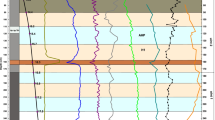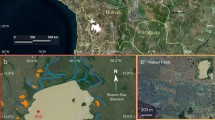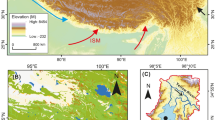Abstract
Ecosystem variability must be assessed over a range of timescales in order to fully understand natural ecosystem processes. Long-term climate change, at millennial and centennial scales, is a major driver of natural ecosystem variability, but identifying evidence of past climate change is frequently confounded by human-induced impacts on the ecosystem. Iceland is a location where it is possible to separate natural from anthropogenic change in environmental archives, as the date of settlement is accepted to be around AD 874, prior to which the island was free from proven human impacts. We used a lake sediment core from Breiðavatn, near Reykholt, a major farm of the Norse period in western Iceland, to examine landscape development. A change in pollen concentration in the sediments, especially the decline in Betula, indicated initial landscape degradation immediately post-settlement, whereas the chironomid fauna and reconstructed temperatures were relatively complacent during this period. The pollen evidence is corroborated by 14C analyses, which indicate an increase in older carbon entering the lake, inferred to have been caused by increased erosion following settlement. Further decreases in Betula pollen occurred around AD 1300, pre-dating a drop in chironomid-inferred temperatures (CI-T) of ~1°C over 100–200 years. The CI-T reconstruction also shows a significant cooling after ~AD 1800, likely indicative of the coldest phase of the Little Ice Age. The evidence suggests that the chironomid record was relatively unaffected by the increased landscape degradation and hence reveals a temperature reconstruction independent of human impact.





Similar content being viewed by others
References
Aaby B, Berglund BE (1986) Characterization of peat and lake deposits. In: Berglund BE (ed) Handbook of Holocene Palaeoecology and Palaeohydrology. John Wiley and Sons, Chichester, pp 231–246
Andresen CS, Björck S (2005) Holocene climate variability in the Denmark Strait region. Geogr Ann 87:159–174. doi:10.1111/j.0435-3676.2005.00250.x
Andrews JT, Giraudeau J (2003) Multi-proxy records showing significant Holocene environmental variability: the inner N. Iceland shelf (Hunafloi). Quat Sci Rev 22:175–193
Arnalds A (2005) Approaches to landcare–a century of soil conservation in Iceland. Land Degrad Dev 16:113–125
Axford Y, Miller GH, Geirsdóttir Á, Langdon PG (2007) Holocene temperature history of northern Iceland inferred from subfossil midges. Quat Sci Rev 26:3344–3358. doi:10.1016/j.quascirev.2007.09.003
Barley EM, Walker IR, Kurek J, Cwynar LC, Mathewes RW, Gajewski K, Finney BP (2006) A northwest north American training set: distribution of freshwater midges in relation to air temperature and lake depth. J Paleolimnol 36:295–314. doi:10.1007/s10933-006-0014-6
Benediktsson J (ed) (1968) Íslensk fornrit I–Landnámabók. Hið íslenska fornritafélag, Reykjavík
Bennett KD (2008a) Psimpoll and pscomb programs for plotting and analysis. http://www.chrono.qub.ac.uk/psimpoll/psimpoll.html (last accessed 16 May 2008)
Bennett K (2008b) Catalogue of pollen types. http://www.chrono.qub.ac.uk/pollen/pc-intro.html (last accessed: 16 May 2008)
Brodersen KP, Odgaard B, Vestergaard O, Anderson NJ (2001) Chironomid stratigraphy in the shallow and eutrophic Lake Søbygaard, Denmark: chironomid-macrophyte co-occurrence. Freshw Biol 46:253–267. doi:10.1046/j.1365-2427.2001.00652.x
Brodersen KP, Quinlan R (2006) Midges as palaeoindicators of lake productivity, eutrophication and hypolimnetic oxygen. Quat Sci Rev 25:1195–2012. doi:10.1016/j.quascirev.2005.03.020
Brooks SJ (2006) Fossil midges (Diptera: Chironomidae) as palaeoclimatic indicators for the Eurasian region. Quat Sci Rev 25:1894–1910. doi:10.1016/j.quascirev.2005.03.021
Brooks SJ, Birks HJB (2004) The dynamics of Chironomidae (Insecta: Diptera) assemblages in response to environmental change during the past 700 years on Svalbard. J Paleolimnol 31:483–498. doi:10.1023/B:JOPL.0000022547.98465.d3
Brooks SJ, Langdon PG, Heiri O (2007) The identification and use of Palaearctic Chironomidae larvae in palaeoecology. QRA Technical Guide No. 10. Quaternary Research Association, London
Bronk-Ramsey C (2005) OxCal Version 3.10 http://www.rlaha.ox.ac.uk/O/oxcal.php
Buckland PC, Dugmore AJ, Perry DW, Savory D, Sveinbjarnardóttir G (1990) Holt in Eyjafjallasveit, Iceland. A paleoecological study of the impact of Landnám. Acta Archaeol 61:252–271
Caseldine C (2001) Changes in the Holocene record from Iceland–a palaeoclimatic record or evidence for early Holocene hybridisation? Rev Pal Pal 117:139–152
Caseldine CJ, Geirsdóttir Á, Langdon PG (2003) Efstadalsvatn–a multi-proxy study of a Holocene lacustrine sequence from NW Iceland. J Paleolimnol 30:55–73. doi:10.1023/A:1024781918181
Caseldine CJ, Langdon PG, Holmes N (2006) Early Holocene climate variability and the timing and extent of the Holocene Thermal Maximum (HTM) in Northern Iceland. Quat Sci Rev 25:2314–2331. doi:10.1016/j.quascirev.2006.02.003
Church MJ, Dugmore AJ, Mairs KA, Millard AR, Cook GT, Sveinbjarnardóttir G, Ascough PA, Roucoux KH (2007) Charcoal production during the norse and early medieval periods in Eyjafjallahreppur, southern Iceland. Radiocarbon 49:659–672
Cook ER, D’Arrigo RD, Mann ME (2002) A well-verified, multiproxy reconstruction of the winter North Atlantic oscillation index since A.D. 1400. J Clim 15:1754–1764. doi:10.1175/1520-0442(2002)015<1754:AWVMRO>2.0.CO;2
Cranston PS (1982) A key to the larvae of the British Orthocladinae (Chironomidae). Scientific publication 45, Windermere, Freshwater Biological Association
Dean WE (1974) Determination of carbonate and organic matter in calcareous sediments and sedimentary rocks by loss on ignition: comparison with other methods. J Sediment Petrol 44:242–248
Dugmore AJ, Cook GT, Shore JS, Newton AJ, Edwards KJ, Larsen G (1995) Radiocarbon dating tephra layers in Britain and Iceland. Radiocarbon 37:379–388
Dugmore AJ, Buckland PC, Church M, Edwards KJ, Lawson I, McGovern TH, Panagiotakopulu E, Simpson IA, Skidmore P, Sveinbjarnardóttir G (2005) The Norse landnám on the North Atlantic islands: an environmental impact assessment. Polar Rec (Gr Brit) 41:21–37. doi:10.1017/S0032247404003985
Dugmore AJ, Borthwick DM, Buckland PC, Church MJ, Dawson AG, Edwards KJ, Keller C, Mayewski P, McGovern TH, Mairs K-A, Sveinbjarnardóttir G (2007) The role of climate in settlement and landscape change in the North Atlantic islands: an assessment of cumulative deviations in high resolution proxy climate records. Hum Ecol 35:169–178. doi:10.1007/s10745-006-9051-z
Edwards KJ, Lawson IT, Erlendsson E, Dugmore AJ (2005) Landscapes of contrast in Viking Age Iceland and the Faroe Islands. Landscapes 6:63–81
Edwards KJ, Langdon PG, Sugden H (2007) Separating climatic and possible human impacts in the early Holocene: biotic response around the time of the 8200 cal. yr BP event. J Quat Sci 22:77–84. doi:10.1002/jqs.1018
Edwards KJ, Whittington G (2001) Lake sediments, erosion and landscape change during the Holocene in Britain and Ireland. Catena 42:143–173. doi:10.1016/S0341-8162(00)00136-3
Einarsson MA (1992) Climatic conditions of the Thingvallavatn area. Oikos 64:96–104. doi:10.2307/3545045
Erlendsson E (2007) Environmental change around the time of the Norse settlement of Iceland. Unpublished PhD thesis, University of Aberdeen
Eyþórsson B (2007) Búskapur og rekstur staðar í Reykholti. Unpublished MA thesis, University of Iceland
Fægri K, Iversen J (1975) Textbook of Pollen Analysis, 3rd edn. Blackwell Scientific Publications, Oxford
Grimm EC (1991) TILIA and TILIA GRAPH. Illinois State Museum, Springfield
Grimm EC (2004) TGView. Illinois State Museum, Springfield
Grönvold K, Óskarsson N, Johnsen J, Clausen HB, Hammer CU, Bond G, Bard E (1995) Ash layers from Iceland in the Greenland GRIP ice core correlated with oceanic and land sediments. Earth Planet Sci Lett 135:149–155. doi:10.1016/0012-821X(95)00145-3
Hallsdóttir M (1987) Pollen analytical studies of human influence on vegetation in relation to the Landnám Tephra layer in Southwest Iceland. Lundqua Thesis, Lund University, Lund
Haraldsson HV, Ólafsdóttir R (2003) Simulating vegetation cover dynamics with regards to long-term climatic variations in sub-Arctic landscapes. Global Planet Change 38:313–325
Heiri O, Lotter AF (2001) Effects of low count sums on quantitative environmental reconstructions: an example using subfossil chironomids. J Paleolimnol 26:343–350
Hofmann W (1971) Zur Taxonomie und Palökologie subfossiler Chironomiden (Dipt.) in Seesedimenten. Arch Hydrobiol 6:1–50
Icelandic Meteorological Office http://www.vedur.is/ (last accessed 30 May 2008)
Jiang H, Seidenkrantz M-S, Knudsen KL, Eiríksson J (2002) Late-Holocene summer sea-surface temperatures based on a diatom record from the north Icelandic shelf. Holocene 12:137–147
Jiang H, Eiríksson J, Schulz M, Knudsen KL, Seidenkrantz M-S (2005) Evidence for solar forcing of sea-surface temperature on the North Icelandic Shelf during the late Holocene. Geology 33:73–76. doi:10.1130/G21130.1
Jowsey PC (1966) An improved peat sampler. New Phytol 65:245–248. doi:10.1111/j.1469-8137.1966.tb06356.x
Karlsdóttir L, Thórsson ÆT, Hallsdóttir M, Sigurgeirsson A, Eysteinsson T, Anamthwhat-Jónsson K (2007) Differentiating pollen of Betula species from Iceland. Grana 46:78–84. doi:10.1080/00173130701237832
Kjartansson G, Þórarinsson S, Einarsson Þ (1964) C14-datings on samples regarding Icelandic Quaternary geology. Náttúrufræðingurinn 34:98–145
Lang B, Bedford AP, Richardson N, Brooks SJ (2003) The use of ultrasound in the preparation of carbonate and clay sediments for chironomid analysis. J Paleolimnol 30:451–460
Langdon PG, Holmes N, Caseldine CJ (2008) Environmental controls on modern chironomid faunas from NW Iceland and implications for reconstructing climate change. J Paleolimnol 40:273–293. doi:10.1007/s10933-007-9157-3
Langdon PG, Ruiz Z, Wynne S, Sayer CD, Davidson TA Ecological influences on larval chironomid communities in shallow lakes: implications for palaeolimnological interpretations. Freshw Biol (in press)
Larocque I (2001) How many chironomid head capsules are enough? A statistical approach to determine sample size for palaeoclimatic reconstructions. Palaeogeogr Palaeoclimatol Palaeoecol 172:133–142. doi:10.1016/S0031-0182(01)00278-4
Larocque I, Hall RI, Grahn E (2001) Chironomids as indicators of climate change: a 100-lake training set from a subarctic region of northern Sweden (Lapland). J Paleolimnol 26:307–322. doi:10.1023/A:1017524101783
Larocque I, Hall RI (2003) Chironomids as quantitative indicators of mean July air temperature: validation by comparison with century-long meteorological records from northern Sweden. J Paleolimnol 29:475–493. doi:10.1023/A:1024423813384
Lawson IT, Church MJ, McGovern TH, Arge S, Woollet J, Edwards KJ, Gathorne-Hardy FJ, Dugmore AJ, Cook G, Buckland PC, Mairs K-A, Thomson AM, Sveinbjarnardóttir G (2005) Mutual adjustment of environment and society on Sandoy, Faroe Islands: palaeoenvironmental and archaeological perspectives. Hum Ecol 33:651–684. doi:10.1007/s10745-005-7681-1
Lawson IT, Gathorne-Hardy FJ, Church MJ, Newton AJ, Edwards KJ, Dugmore AJ, Einarsson Á (2007) Environmental impacts of the Norse settlement: palaeoenvironmental data from Mývatnssveit, northern Iceland. Boreas 36:1–19. doi:10.1080/03009480600827298
Mäkelä EM (1996) Size distribution between Betula pollen types–a review. Grana 35:248–256
McKinzey KM, Olafsdottir R, Dugmore AJ (2005) Perception, history, and science: coherence or disparity in the timing of the Little Ice Age maximum in southeast Iceland? Polar Rec (Gr Brit) 41:319–334. doi:10.1017/S0032247405004687
Moller-Pillot HKM, Buskens RFM (1990) De larven der Nederlandse Chironomidae (Diptera). C: Autoekologie en verspreiding. Nederlandse Faunistische Mededelingen 1C:1–277
Moore PD, Webb JA, Collinson ME (1991) Pollen Analysis, 2nd edn. Blackwell Science, Oxford
Ólafsdóttir R, Guðmundsson HJ (2002) Holocene land degradation and climatic change in northeastern Iceland. Holocene 12:159–167. doi:10.1191/0959683602hl531rp
Ólafsdóttir R, Schlyter P, Haraldsson HV (2001) Simulating Icelandic vegetation cover during the Holocene. Implications for long-term land degradation. Geogr Ann 83:203–215. doi:10.1111/j.0435-3676.2001.00155.x
Quinlan R, Smol JP (2001) Setting minimum head capsule abundance and taxa deletion criteria in chironomid-based inference models. J Paleolimnol 26:327–342. doi:10.1023/A:1017546821591
Rieradevall M, Brooks SJ (2001) An identification guide to subfossil Tanypodinae larvae (Insecta: Diptera: Chironomidae) based on cephalic setation. J Paleolimnol 25:81–99. doi:10.1023/A:1008185517959
Róbertsdóttir BG (1992) Gjóskulagatímatal fyrir Suðurlandsundirlendi. Forsöguleg gjóskulög frá Kötlu, áður nefnd Katla 5000. In Veggspjaldaráðstefna Jarðfræðafélags Íslands, 28 Apríl 1992. Jarðfræðafélag Íslands, Reykjavík, pp 8–9
Smith KP (1995) Landnám: the settlement of Iceland in archaeological and historical perspective. World Archaeol 26:319–347
Stockmarr J (1971) Tablets with spores used in absolute pollen analysis. Pollen Spores 13:614–621
Sveinbjarnardóttir G, Erlendsson E, Vickers K, McGovern TH, Milek K, Edwards KJ, Simpson IA, Cook G (2007) The palaeoecology of a high status Icelandic farm. Environ Archaeol 12:197–216
ter Braak CJF, Smilauer P (1998) CANOCO reference manual and user’s guide to Canoco for windows: software for canonical community ordination (version 4.5.1). Microcomputer Power, Ithaca
Velle G, Brooks SJ, Birks HJB, Willassen E (2005a) Chironomids as a tool for inferring Holocene climate: an assessment based on six sites in southern Scandinavia. Quat Sci Rev 24:1429–1462. doi:10.1016/j.quascirev.2004.10.010
Velle G, Larsen J, Eide W, Peglar SM, Birks HJB (2005b) Holocene environmental history and climate of Råtåsjøen, a low-alpine lake in south-central Norway. J Paleolimnol 33:129–153. doi:10.1007/s10933-004-2689-x
Walker IR, Cwynar LC (2006) Midges and palaeotemperature reconstruction–the north American experience. Quat Sci Rev 25:1911–1925. doi:10.1016/j.quascirev.2006.01.014
Wiederholm T (1983) Chironomidae of the Holarctic region, keys and diagnoses. Part 1. Larvae. Entomol Scand 19:1–457
Woodward CA, Shulmeister J (2005) A Holocene record of human induced and natural environmental change from lake Forsyth (Te wairewa), New Zealand. J Paleolimnol 34:481–501. doi:10.1007/s10933-005-5708-7
Þorláksson H (2000) Icelandic society and Reykholt in the 12th and 13th centuries with special reference to Snorri Sturluson. In: Sveinbjarnardóttir G (ed) Reykholt in Borgarfjörður. National Museum of Iceland, Reykjavík, pp 11–20
Acknowledgments
This work was funded by the Leverhulme Trust and the Icelandic Research Fund for Graduate Students. We thank Guðrún Sveinbjarnardóttir for her comments and assistance, Ian Lawson and Mike Church for their help during coring, Andy Dugmore for the geochemical analyses of tephra samples and the owners of the land surrounding Breiðavatn for kindly allowing us access. Bob Smith from the Cartographic unit, University of Southampton helped with drawing the figures. The valuable comments of two anonymous referees helped to improve the manuscript.
Author information
Authors and Affiliations
Corresponding author
Rights and permissions
About this article
Cite this article
Gathorne-Hardy, F.J., Erlendsson, E., Langdon, P.G. et al. Lake sediment evidence for late Holocene climate change and landscape erosion in western Iceland. J Paleolimnol 42, 413–426 (2009). https://doi.org/10.1007/s10933-008-9285-4
Received:
Accepted:
Published:
Issue Date:
DOI: https://doi.org/10.1007/s10933-008-9285-4




